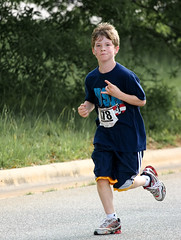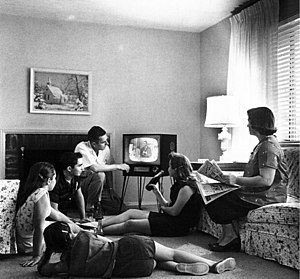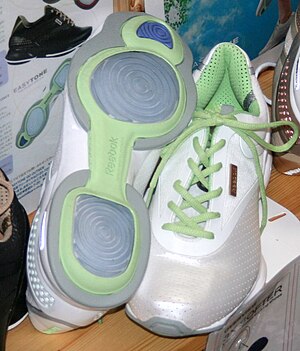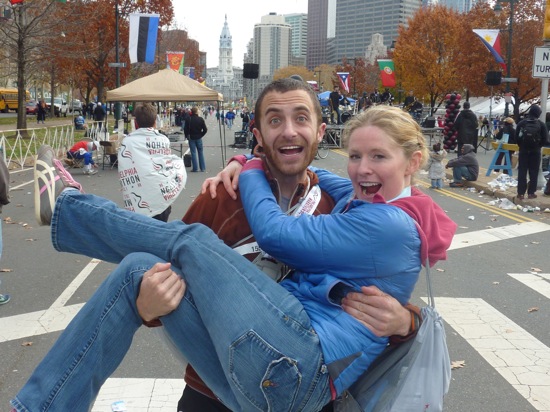My background is in digital marketing, websites and other work online, so the prospect of developing an expertise in event planning was not exactly on my bucket list. However, after my wife and I successfully hosted our wedding in rural Lyle, Wa, I feel like I might just have a winning second career planning seating charts and designing hand-crafted decorations.
This is our wedding story....
The proposal
"This is perfect!" I thought. My girlfriend had just accepted my marriage proposal, a thrown-together affair that involved me pledging my love to her at the finish of my first 100-mile race, the 2011 Lumberjack 100-Mile Endurance Run. Originally I envisioned planning out an elaborate, romantic date where I'd pop the question, however as I ran through the night at Lumberjack, it just felt like now was the right time and place. Earlier that week Sophia and I got Luna, a 4-month-old border collie / terrier puppy, and Sophia had just WON the 50-mile distance at Lumberjack. So when I finished the race five hours later, I decided to just go for it.
After sprinting the last few yards to cross the finish line, Sophia embraced my filthy body, disregarding the layers of mud and sweat I wore on my skin, shirt and shorts. We hugged and kissed.
I asked Sophia if we could speak in private, and she guided my exhausted body a few feet from where the other race finishers were gathered. Without a ring, flowers, or even the strength to kneel on one knee, I popped the question and Sophia replied "Yes, of course!" while grinning and nodding. Her acceptance marked the beginning of a new chapter in our relationship: our engagement... and the start of wedding planning. At the time I didn't realize that I was about to embark on an entirely new type of endurance event.
(I ended up re-doing my proposal, this time with a ring, just a month later at the Lost Lake 50K so I'd be legit and get the moment on camera. Luckily, Sophia again said yes!)
With Sophia's family in New Zealand and my folks living in New York, she and I knew that the majority of the wedding planning would be done on our own. Our budget didn't allow for a professional planner, and we're not the cookie-cutter type, so a banquet hall was out, too. After discussing several options, Sophia and I came up with a plan. "Let's get married at Tara's", we collectively declared.
The location
Tara Peyralans is a longtime friend of Sophia's family and lives just outside of the small town of Lyle, Wa, about four hours from Seattle. Her log cabin home is found half a mile down a dirt road and sits on 60+ acres full of scrub oak and dry prairie grass. While lacking easy access to hotels, supermarkets and the commonalities of urban life, Tara's property could't be more scenic or fitting for a rustic wedding. As trail runners, Sophia and I knew this was the perfect place to exchange vows. Within a few days Sophia and I brought up the idea to Tara on a phone call and Tara very graciously agreed to host us. Location, check!
"Think of all the money we'll save by not having to pay for a venue!" Sophia and I proclaimed.
The only challenge now? Well, we lacked a caterer, ceremony officiant, seating, lights, water and the majority of our guests lived hundreds and even thousands of miles away in locations as spread out as British Columbia, Kenya and New Zealand. Luckily, this didn't deter us. Here's how Sophia and I pulled off our rustic rural wedding.
The real planning begins
Sophia and I had plenty of time to plan our wedding ceremony and reception, because instead of aiming for a day in August of 2011, the summer following my proposal, we decided to host our wedding in August of the following year. This gave us a solid 16 months to save and prepare for our big day.
To stay organized, we kept a list of guests and their addresses in a Google document that we each contributed to. We even used a simple google form to collect the mailing addresses of all the guests.
In the same Google Doc, we added a budget tab to estimate expenses and also started tracking what items we would need to borrow, rent or buy. Staying organized helped to quell our fear.
How will we afford this? Where will we get all the supplies? Will people really show up?
These questions occasionally buzzed around in our minds, but we tried to stay calm by working on the things we could, and by repeating the mantra "It'll all work out...It'll all work out." Drinking plenty of wine helped, too.
Instead of relying on a wedding planning guides or month-by-month planning spreadsheets provided by friends, Sophia and I just made lists of questions we had as they arose and hunted for answers online or by calling businesses. Sophia took charge of finding a florist, wedding dress and caterer. I researched the ceremony run-of-show and equipment rental companies where we could pick up a power generator and sound equipment. Each week we spent 1-2 hours on the wedding, either updating mailing addresses of long-distance friends or sifting through Pinterest for homemade decorations.
As our plans began to firm up, we put together a wedding website with all the details about the event including where to camp out before the big day, and the literary of our fun run, or as we called it, Matrimonial 5-miler. Having a website might sound excessive, but the process of building the site was actually really rewarding (well, maybe we didn't need the Wedding Trailer). The template we used gave us a great foundation to start from and list of categories we should consider like accommodations, and "our story". Storing all our information in a website also meant we didn't have to keep our family and friends guessing.
Cheesy as it might sound, I loved working on this process together. It gave Sophia and I something to reflect on--an important and often overlooked practice during one's engagement. As the months passes, the wedding ceremony, reception and weekend of celebration began to come into focus. The rustic adventure Sophia and I were hoping for was being realized in true country form.
But what about food?
Initially, we had hoped to have a local caterer cook and serve a buffet for our wedding guests on Tara's land, however our search kept running into dead ends. A friend of Tara's highly recommended the catering services of the Lyle Hotel. Unfortunately, that business shut down the summer prior. And because Tara was already offering us so much, asking her to cook for 60 or 70 of our closest friends was out of the question. As a rural community, there were few catering options so we knew we had to get creative. Maybe a BYOF wedding? Hmm..
Inspired by a friend's food truck business and with a suggestion from one of my groomsman, we got the idea that we could get a truck to cater our reception, instead of a traditional caterer. While our friend Sam's Seattle Biscuit Company couldn't make it to Lyle, we were able to find a top-notch truck in Portland, Thrive Pacific NW, who agreed to drive the 70+ miles to Lyle. Their menu included organic and gluten-free dishes, so Sophia was game. I loved their storytelling and logo.
Next up, who's going to marry us?
Our officiant (and musician, aunt & superhero)
Washington state requires an ordained minister to officiate a wedding, so Sophia and I knew we would have to track down a professional to host our union. But who? We go to the 'church' of mountains for our spiritual development, so no ordained names instantly jumped to mind. Luckily, after doing some research online, we discovered that WA permits any ordained religious leader to officiate, but does not license the process. The Wa guidelines actually say that... they DO NOT verify... basically anybody, ordained by any religion, can do it. Interesting....
After a few minutes of searching online and a call with my Aunt Ellyn in Pennsylvania, we had an officiant! Ellyn agreed to get ordained through an online church and a few minutes later was armed-to-marry. Officiant, check!
Through later planning, Ellyn and her family also agreed to play live music during our ceremony and reception, including the hit You and I by Ingrid Michaelson. I can't thank her family enough! They are a talented and accommodating bunch.
And the rest of the stuff
Over the next few months, the rest of the details came together wonderfully. We set up a Honeyfund account to collect gifts from our guests. This funded our honeymoon, or as we like to call it, mega-moon to visit Sophia's family in Kenya. This journey even included fulfilling the dream of summiting Mt. Kenya. Score!
Going into the experience, we knew we had a budget to cover some extravagances, but not every bell and whistle. Sophia and I both value photos, so we knew we'd spring for a professional photographer. Luckily we were able to connect with the very talented, Sarah Heitman, a friend-of-a-friend (and fellow athlete). Sophia also wanted a quality dress and was thrilled by the services of Cicada Bridal.
For the rest of the wedding needs, Sophia and I just kinda figured things out. The rental chairs and lights came from the charming local rental company Riverhood. For refreshments, we made arrangements with a friend, Kevin, owner of the fantastic Northwest Peaks Brewery, to drive in two kegs of his best Ballard-brewed beer. We also bought honey from a local beekeeper to make table gifts for each guest. Oh, and we can't forget the wine. We bought 30+ bottles of white and red wine from a local Safeway.
The big day is approaching
Instead of wedding cake, we opted for pies made by a local baker Pauline. And friends and family helped create decorations, including the bunting adorning our reception, expertly sewn by Heidi Burford-Bell, one of Sophia's bridesmaids.
With all the major plans in place and the budget still holding, Sophia and I just started letting go and relaxing. The wedding was coming soon, but we had done all the planning we could do. So, we just went with the flow and relaxed. We had faith that all would work out.
On the wedding weekend my Dad and brother Mike spent hours rigging up the rented generator and lights. Countless other friends and family also helped with everything from setting up chairs, to playing music and general crowd control. Kudos also to Theresa, Tara's sister-in-law, who served as the general manager on the day of the rehearsal dinner and wedding. While Sophia and I toasted champagne, it was Theresa who made sure the night went off without a hitch.
How it turned out
We wanted to make the entire wedding affair not just a single day of fun, but weekend of celebration. I think we pulled that off. Sophia's family were kind enough to rent a sizable luxury house overlooking the scenic Columbia River in a town just down from Lyle. This was the wedding party's basecamp and is where we stayed for the week leading up to the wedding. The kitchen housed many group dinners and games of Cards Against Humanity. Having this time to spend family we rarely got to visit with was essential and made the whole experience that much more rewarding.
Matrimonial Five-Miler
To kick off wedding weekend, Sophia and I held the Matrimonial Fun Run, a five-mile race along the scenic Klickitat trail. Decked out in wedding themed running attire, the majority of runners took it easy on the race. That is except for Gary and I. After chatting for most of the run, with about a mile left, we dropped the hammer and sprinted for the finish.
Unfortunately, Gary (aka sponsored Salomon professional ultra-runner-of-the-year ) had more hammer to drop, and I finished about 10 yards back from him. He smiled, I panted. The rest of the runners took a more responsible pace and finished without profusely sweating and gasping for air.
Rehearsal Dinner
Tara not only allowed us to host our wedding on her property and put up with us when I weed-whacked a spot in her meadow grass for our wedding ceremony, she also cooked our entire wedding party the rehearsal dinner. And this wasn't just some tv dinner affair either. Tara and her daughters plated salmon, harvested salad from her garden and cooked gluten-free chocolate molten cake for the entire wedding party. The spread was breathtaking--I almost didn't want to eat it. Almost.
As the light dimmed on the hills outside Lyle, I was so grateful that our friends had come together to celebrate our union. It's not cheap to take off from work and fly across the country. I'm so glad we were all able to come together.
The Ceremony & Reception
On the morning of the wedding, I headed over to Tara's early to put up the last of the decorations with my family while Sophia stayed back at the White Salmon house to get dressed with her bridesmaids. The weather was surprisingly August in Lyle, and to our blessing, the wind wasn't upturning tables or thrashing decorations like it often is in that area.
What I learned from the experience
A few thoughts...
- Event planning is complex, but if you take it one step at a time, even a complicated rural, self-organized party like the one I had is possible.
- Early in the process, discuss with your partner exactly what you each want the event to look and feel like. Having a consistent vision will prevent disagreements and hurt feelings down the road. Talk and write down what you think.
- Google is your friend. We used it for everything from storing our guest list to searching for text to base our vows on.
- Weddings are expensive. Even a modest wedding will run $50-$100 per person in most areas. Yes, even when you are really, really thrifty. If that sounds too pricey, consider renting out a restaurant for an afternoon and doing an appetizer-only reception. This would make a shorter affair, but will save you lots of cash in the end. Luckily, our parents chipped in and we used some of our savings to pull the event off. No debt incurred.
- Talk to friends who were recently married about what things they saved money on, and what areas they splurged on.
- Sophia and I each selected parts of the wedding we wanted to work on. This really worked out well for us because we each felt ownership over different parts of the affair.
- Don't forget the most important part: the relationship is what matters. The dress, rings, flowers and even family and friends aren't really why you're there. They compliment the experience, but the core of the experience is the partnership. Spend your time and energy on this more than anything else.








































